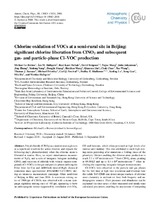| dc.contributor.author | Le Breton, Michael | |
| dc.contributor.author | Hallquist, Åsa M. | |
| dc.contributor.author | Pathak, Ravi Kant | |
| dc.contributor.author | Shallcross, Dudley E. | |
| dc.date.accessioned | 2018-09-17T07:17:30Z | |
| dc.date.available | 2018-09-17T07:17:30Z | |
| dc.date.issued | 2018 | |
| dc.identifier.citation | Le Breton, Michael. et al. (2018). Chlorine oxidation of VOCs at a semi-rural site in Beijing: significant chlorine liberation from ClNO2 and subsequent gas- and particle-phase Cl–VOC production. Atmospheric Chemistry and Physics, 18: 13013–13030 | en_US |
| dc.identifier.issn | 1680-7316 | |
| dc.identifier.uri | https://doi.org/10.5194/acp-18-13013-2018 | |
| dc.identifier.uri | http://hdl.handle.net/10566/4044 | |
| dc.description.abstract | Nitryl chloride (ClNO2) accumulation at night acts
as a significant reservoir for active chlorine and impacts the
following day’s photochemistry when the chlorine atom is
liberated at sunrise. Here, we report simultaneous measurements
of N2O5 and a suite of inorganic halogens including
ClNO2 and reactions of chloride with volatile organic compounds
(Cl–VOCs) in the gas and particle phases utilising the
Filter Inlet for Gas and AEROsols time-of-flight chemical
ionisation mass spectrometer (FIGAERO-ToF-CIMS) during
an intensive measurement campaign 40 km northwest
of Beijing in May and June 2016. A maximum mixing ratio
of 2900 ppt of ClNO2 was observed with a mean campaign
nighttime mixing ratio of 487 ppt, appearing to have
an anthropogenic source supported by correlation with SO2,
CO and benzene, which often persisted at high levels after
sunrise until midday. This was attributed to such high mixing
ratios persisting after numerous e-folding times of the
photolytic lifetime enabling the chlorine atom production to
reach 2.3 105 molecules cm3 from ClNO2 alone, peaking
at 09:30 LT and up to 8.4 105 molecules cm3 when including
the supporting inorganic halogen measurements.
Cl–VOCs were observed in the particle and gas phases
for the first time at high time resolution and illustrate how
the iodide ToF-CIMS can detect unique markers of chlorine
atom chemistry in ambient air from both biogenic and anthropogenic
sources. Their presence and abundance can be
explained via time series of their measured and steady-state
calculated precursors, enabling the assessment of competing OH and chlorine atom oxidation via measurements of products
from both of these mechanisms and their relative contribution
to secondary organic aerosol (SOA) formation. | en_US |
| dc.language.iso | en | en_US |
| dc.publisher | European Geosciences Union (EGU) | en_US |
| dc.rights | © Author(s) 2018. This work is distributed under
the Creative Commons Attribution 4.0 License. | |
| dc.subject | Chlorine oxidation | en_US |
| dc.subject | Beijing | en_US |
| dc.subject | ClNO2 | en_US |
| dc.subject | photochemistry | en_US |
| dc.title | Chlorine oxidation of VOCs at a semi-rural site in Beijing: significant chlorine liberation from ClNO2 and subsequent gas- and particle-phase Cl–VOC production | en_US |
| dc.type | Article | en_US |
| dc.privacy.showsubmitter | FALSE | |
| dc.status.ispeerreviewed | TRUE | |

